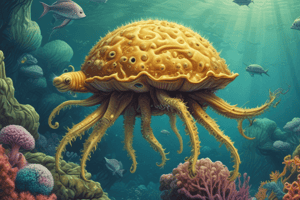Podcast
Questions and Answers
What type of predators are comb jellies according to the text?
What type of predators are comb jellies according to the text?
- Carnivores (correct)
- Detritivores
- Omnivores
- Herbivores
Which body part of Ctenophora contains a brain-like organ?
Which body part of Ctenophora contains a brain-like organ?
- Aboral pole (correct)
- Oral end
- Comb rows
- Mouth
What distinguishes the locomotion of Ctenophora from Cnidarian Jellyfish?
What distinguishes the locomotion of Ctenophora from Cnidarian Jellyfish?
- Bioluminescence
- Use of cnidae
- Muscle contractions
- Use of cilia (correct)
How many species of Ctenophora are approximately present in coastal waters?
How many species of Ctenophora are approximately present in coastal waters?
Which feature contributes to the near invisibility of Ctenophora in water?
Which feature contributes to the near invisibility of Ctenophora in water?
How do comb jellies primarily move?
How do comb jellies primarily move?
What distinguishes the body plan of Ctenophora and Cnidarians?
What distinguishes the body plan of Ctenophora and Cnidarians?
What is the significant difference between Ctenophores and Cnidarian Jellyfish in terms of locomotion?
What is the significant difference between Ctenophores and Cnidarian Jellyfish in terms of locomotion?
What distinguishes Beroe sp from other Ctenophores in terms of coloration?
What distinguishes Beroe sp from other Ctenophores in terms of coloration?
What sets apart Pleurobranchhia among Ctenophores during nighttime?
What sets apart Pleurobranchhia among Ctenophores during nighttime?




